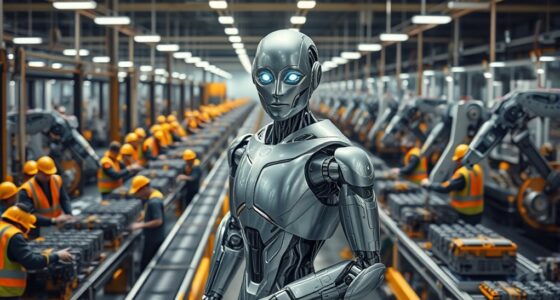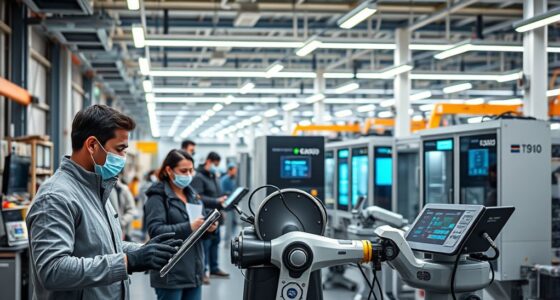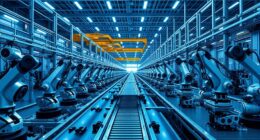You’ll see that countries with advanced infrastructure, supportive policies, and a skilled workforce adopt automation faster and face bigger job losses. Regions like Asia, especially South Korea and Japan, lead in robot density, while developing nations struggle with costs, skills, and infrastructure gaps. Industries heavily reliant on manual labor or manufacturing are especially vulnerable. To understand how these disparities shape global employment dynamics and what can be done, keep exploring this complex topic further.
Key Takeaways
- Countries with advanced infrastructure and supportive policies adopt automation faster, increasing job displacement risks.
- Labor-intensive economies and those with limited access to digital skills face higher job losses due to automation.
- Developing nations struggle with high costs, weak infrastructure, and skill shortages, slowing automation adoption and widening gaps.
- Regional disparities in robot density reflect economic and technological differences, influencing the scale of job impacts.
- Investment in education, upskilling, and sector diversification can mitigate job losses and reduce the global automation divide.
Variations in Automation Adoption Across Regions

Automation adoption varies markedly across regions, driven by factors like technological infrastructure, economic conditions, and regulatory environments. In Asia, countries like South Korea, Japan, and China lead with high robot densities, with South Korea reaching over 1,000 robots per 10,000 employees. Meanwhile, the European Union has a higher robot density of 208 units, and North America follows closely at 188 units. Countries with strong technological infrastructure and supportive policies tend to adopt automation faster, fostering innovation ecosystems that accelerate technological advancements. For example, South Korea and Singapore are at the forefront of robotics innovation. Conversely, regions with less developed infrastructure or stricter regulations lag behind. Overall, the global average robot density has doubled in six years, reflecting uneven progress influenced by regional economic and technological factors. Regional disparities also play a significant role in shaping automation trends worldwide, highlighting the importance of digital transformation initiatives in bridging these gaps. Additionally, the availability of skilled workforce is crucial in effectively implementing automation technologies across different regions. Moreover, ongoing research and development efforts are essential to sustain the pace of automation progress globally, as countries invest in advanced manufacturing capabilities to remain competitive.
Industry-Specific Vulnerabilities and Economic Structures

Different industries face unique challenges and risks from technological advancements, shaped heavily by their economic structures. Manufacturing has experienced significant job losses—1.7 million in the US alone since 2000—due to automation. Retail and customer service sectors could see up to 800 million jobs impacted globally, with automation replacing cashiers and customer reps through AI and self-checkouts. The automotive industry faces potential impacts on around 300 million jobs worldwide from autonomous vehicle technology. In contrast, healthcare’s automation risks are moderate, mainly affecting administrative roles. Transportation jobs, especially driving, are vulnerable as autonomous vehicles develop, but adoption varies by country. Countries with labor-intensive economies or heavy industrial specialization face higher displacement risks, while service-driven economies may see job shifts rather than outright losses. Understanding the economic structures that underpin these sectors can help policymakers craft targeted strategies for workforce adaptation. The small mistakes made during automation implementation can exacerbate these challenges if not carefully managed. As automation technology advances, the labor market is expected to undergo significant transformations, requiring proactive measures. Incorporating workforce reskilling programs can facilitate smoother transitions for affected workers. Well-Being Tips can help workers adapt to these industry shifts and manage stress during transitions.
The Role of Workforce Skills and Education Systems
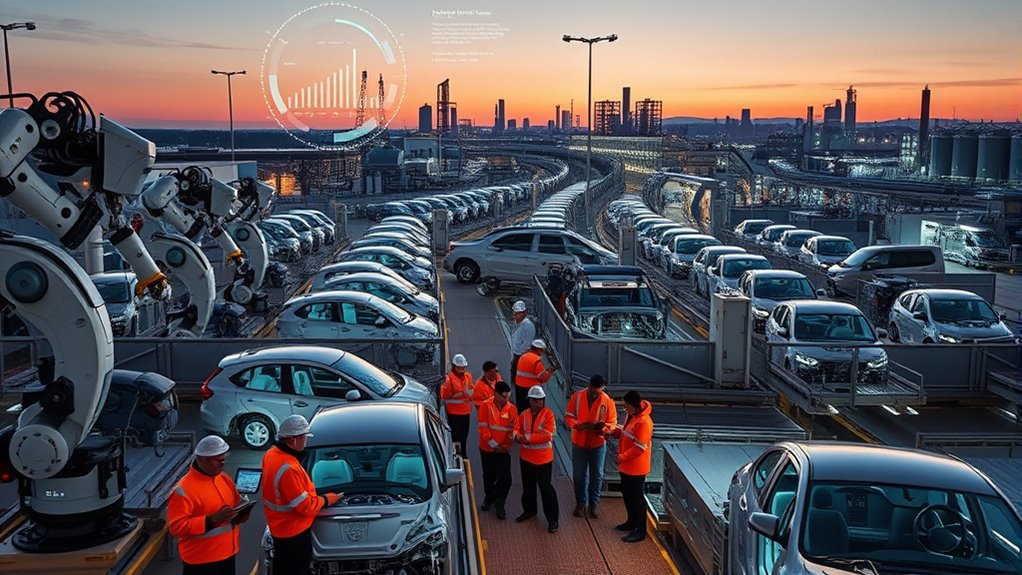
The level of workforce skills and the strength of education systems directly influence how economies cope with automation-driven changes. If your country invests in digital skills and lifelong learning, workers adapt faster, reducing unemployment. Conversely, limited access to quality education worsens the automation impact. Consider these points:
- Higher education workers face lower automation risks.
- Outdated or limited skills increase displacement vulnerability, especially when technological advancements rapidly evolve.
- Gaps in skills hinder transitions into new roles created by AI.
- Countries with strong training and upskilling programs experience smaller job losses and wage growth. Workforce adaptability is essential for maintaining economic stability in the face of automation. Enhancing digital literacy across all education levels can further improve resilience. Additionally, integrating continuous learning initiatives helps workers stay current with evolving technologies.
Having a skilled workforce also attracts investments, further boosting economic resilience. A robust education system that emphasizes STEM, critical thinking, and continuous learning helps workers stay relevant. Countries investing in workforce development are better equipped to handle automation’s challenges, avoiding prolonged unemployment and economic inequality.
Policy and Infrastructure Challenges in Developing Countries
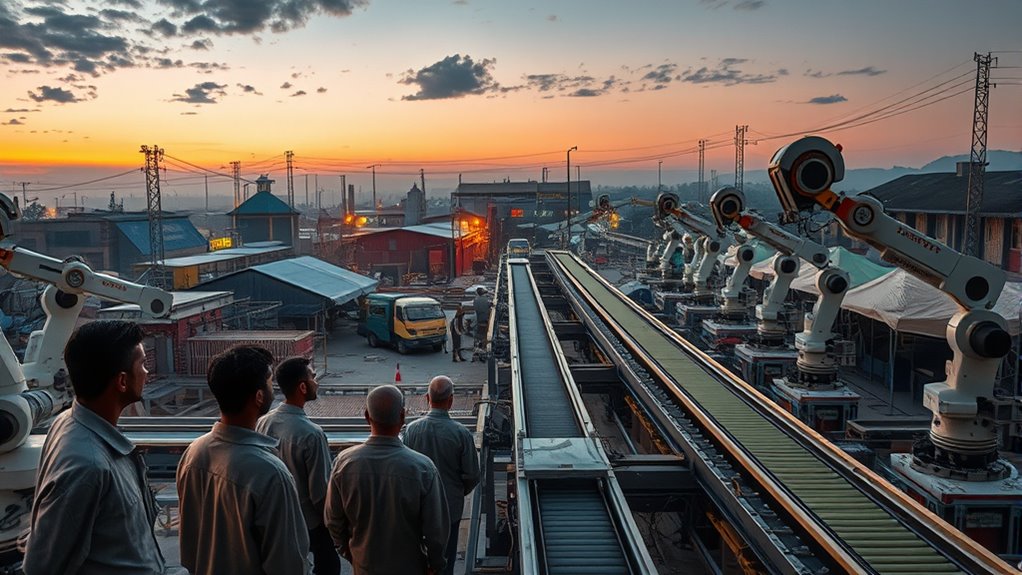
What are the key hurdles preventing developing countries from fully embracing automation? Limited access to finance and investment is a major obstacle. High upfront costs and perceived risks make it difficult for small and medium enterprises to secure funding. Weak financial structures and high-interest rates further discourage automation projects. Additionally, reliance on foreign expertise limits local control and adaptation, as imported solutions may not fit local needs. A shortage of skilled talent hampers maintenance and innovation, creating dependency on external support. Inadequate policy frameworks and weak regulation also hinder progress; without clear incentives or strategies, businesses lack guidance. Poor infrastructure, such as unreliable power and internet, increases operational costs and disrupts automation. These combined challenges slow adoption and deepen the automation divide. Furthermore, studies show that only a small percentage of small firms in developing countries have licensed foreign technology, highlighting limited technological access and adaptation. Addressing these issues requires strengthening technological infrastructure and fostering local expertise to promote sustainable automation growth. Improving local capacity building can help mitigate some of these barriers and enable more inclusive technological advancement.
Strategies for Mitigating the Impact of Job Displacement
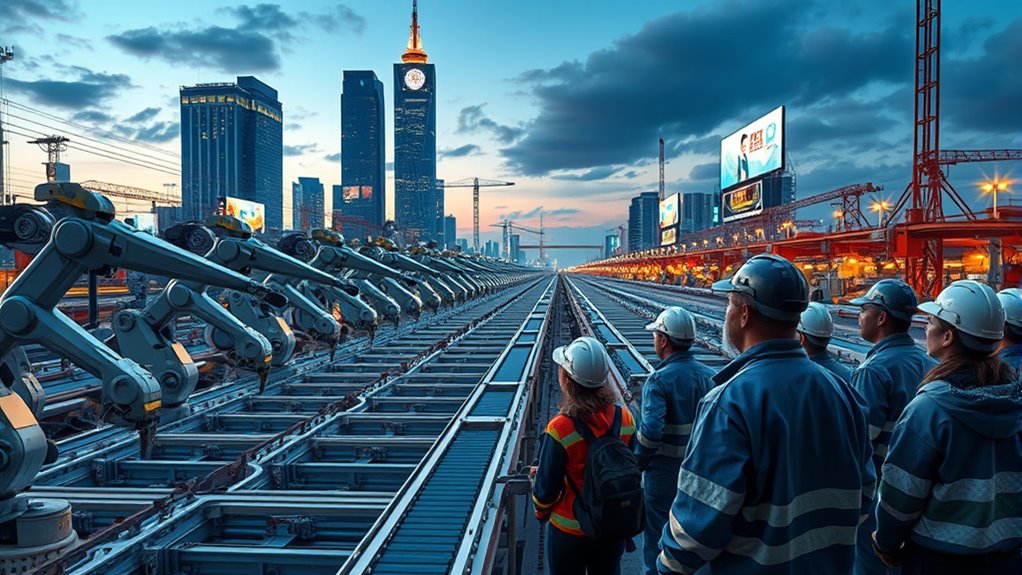
Addressing job displacement caused by automation requires proactive strategies that prepare workers for changing labor markets. You can focus on these key approaches:
- Continuous upskilling programs: Regularly updating skills ensures workers stay relevant in evolving industries.
- Emphasizing digital literacy: Training in coding, AI, and digital tools secures future employability.
- Promoting lifelong learning: Governments and companies incentivize ongoing education across all ages.
- Building public-private partnerships: Collaboration increases access to effective retraining programs.
- Encouraging adaptive skills development: Fostering resilience and flexibility helps workers navigate rapid technological changes.
These strategies help workers adapt, reduce unemployment, and foster economic resilience. By investing in education, support systems, and sector diversification, you create a more flexible workforce capable of steering through automation’s challenges. This proactive approach minimizes job losses and prepares your economy for sustainable growth.
Frequently Asked Questions
How Do Cultural Attitudes Influence Automation Adoption in Different Countries?
You see, cultural attitudes play a big role in how countries adopt automation. If your society views AI as a societal benefit, you’re more likely to embrace it, supported by regulatory frameworks and education. Conversely, if your culture sees AI as a threat, adoption slows down. Factors like risk tolerance, media influence, and economic investment shape these attitudes, ultimately impacting how quickly and widely automation takes hold in different countries.
What Role Do Intellectual Property Laws Play in Automation Technology Spread?
You might think IP laws are just there to protect inventors, but they actually shape how widely automation spreads. Strong patents can lock out developing countries, making innovation seem like an exclusive club. Meanwhile, they attract investments for some. Ironically, these laws aim to encourage innovation but often slow down global access, widening the automation gap. So, your IP rights could be the gatekeeper or the key to worldwide automation progress.
How Does Automation Impact Informal and Gig Economies Globally?
You see, automation transforms informal and gig economies by creating both opportunities and challenges. It helps workers find temporary jobs, bypass social barriers, and utilize skills more flexibly. However, it also puts downward pressure on wages and risks underemployment. You might find that some gig workers experience reduced job stability, especially if they lack the skills to adapt. Overall, automation reshapes how people work in these economies worldwide.
What Are the Environmental Implications of Increased Automation and AI Deployment?
You should consider that increased automation and AI deployment considerably impact the environment. They boost energy demand, especially from data centers that consume vast amounts of electricity and water. This leads to higher emissions, water scarcity, and electronic waste. However, many companies are adopting renewable energy and efficiency measures to lessen these effects. Staying aware of these efforts can help you understand how AI might evolve sustainably and reduce its environmental footprint.
How Can International Organizations Support Equitable Automation Transitions?
International organizations can support equitable automation shifts by establishing clear frameworks and encouraging collaboration among governments, businesses, and civil society. You can promote upskilling programs, provide financial support, and develop policies like wage insurance to help workers adapt. Ensuring transparency about automation plans and building inclusive access to training helps manage expectations and reduce disparities, making sure everyone benefits from technological progress and minimizes negative social impacts.
Conclusion
As you navigate this changing landscape, remember that countries with higher automation adoption risk losing up to 30% of jobs in certain sectors. But by investing in workforce skills and smart policies, you can help bridge the divide. Embracing education and innovation becomes essential when nearly 60% of jobs in developing nations are vulnerable to automation. Together, proactive strategies can turn automation’s challenges into opportunities for growth and resilience.




